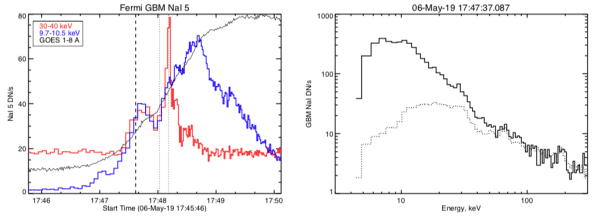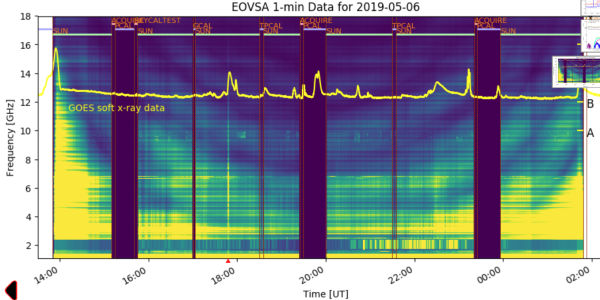A Solar FRB
| Nugget | |
|---|---|
| Number: | 400 |
| 1st Author: | Dale GARY |
| 2nd Author: | Hugh HUDSON |
| Published: | 15 February 2021 |
| Next Nugget: | NuSTAR |
| Previous Nugget: | Richard Schwartz |
Introduction
The idea of a "Fast Radio Burst" (FRB) burst upon the astronomical community only 15 years ago: these are remarkably bright, remarkably fast transient sources. They last for only a few milliseconds! Most of them, quite interestingly, have extragalactic origins, as can be inferred from their frequency dispersion, typically measured in hundreds of pc/cm3. Here the unit pc is the parsec, not normally involved in solar measurements. Many FRBs may be associated with magnetars, which links them to both RHESSI and to solar flares.
Recently a very sensitive FRB detector array detected a FRB-like event that was uniquely solar in origin (Ref. [1]). We'll call it the SFRB, for "solar FRB". This event, observed at 1.4 GHz, lasted for only a few ms with a flux density of 9.1 Mega-Janskys (910 solar flux units) and thus seemed like a true FRB. Here the dispersion measure, still expressed in parsecs, was a minimal 5 pc/cm3, but consistent with zero (or the whole solar corona, which has a scale height of about 1 nanoparsec). Figure 1 shows the STARE2 array detection by two of its receivers--one at the Owens Valley Radio Observatory and one at the Goldstone Deep Space Communications Complex.
The solar event
Our new solar radio observatory, EOVSA, also at Owens Valley, detected something remarkable at about the right time: Figure 2 shows the EOVSA quick-look spectrogram, with the GOES 1-8 A soft X-ray flux superimposed. The C1-class event with a fast broadband radio response occurs just before 18:00 UT, while others of similar strength show nothing obvious.
RHESSI hard X-ray data were not available when this event happened, but Fermi/GBM captured the event, as shown in Figure 3 here. During the time of the SFRB there was hard X-ray emission with extremely hard spectra (index about -2.8), but no coincident spike, so this non-coincidence likely just results from the relatively poor time resolution of the GRB data, 4 s rather than the 19 ms needed to resolve the event.

The EOVSA full time-resolution data provide a closer look, which we summarize in Figure 4 here. EOVSA's high time resolution (20 ms samples) would be enough to detect the event, except that coverage of EOVSA's broad 1-18 GHz range is achieved by time-sharing, rather than continuous sampling. At the time of the STARE2 event (17:47:35.385, Figure 1), EOVSA was 0.385 s into its sweep and was sampling another frequency band (8.25-8.55 GHz), at much higher frequencies than the 1.4 GHz of the STARE2 detection.
Most of the emission in the spectrogram in Figure 4 is incoherent broadband emission from high-energy electrons, but there are signs throughout the spectrum of spiky coherent emission, possibly type III bursts, normally observed in the corona at much lower frequencies. Here we are seeing source electron densities, on the plasma-frequency hypothesis, of 1010 cm-3, which is typical of the chromosphere. Such a high density at the base of an open-field flux tube could only be found in a transient, according to conventional wisdom.
What are the implications here?
Once again, we are indebted to non-solar astronomers for pointing out a potentially large unexplored parameter space. The presence of very short time scales also implies very small spatial scales, and current-day numerical simulations of solar atmospheric structure do not address these scales. They are important because they come closer to the microphysics involved in solar plasma dynamics, and this chance observation should really encourage observers to tackle this parameter range.


